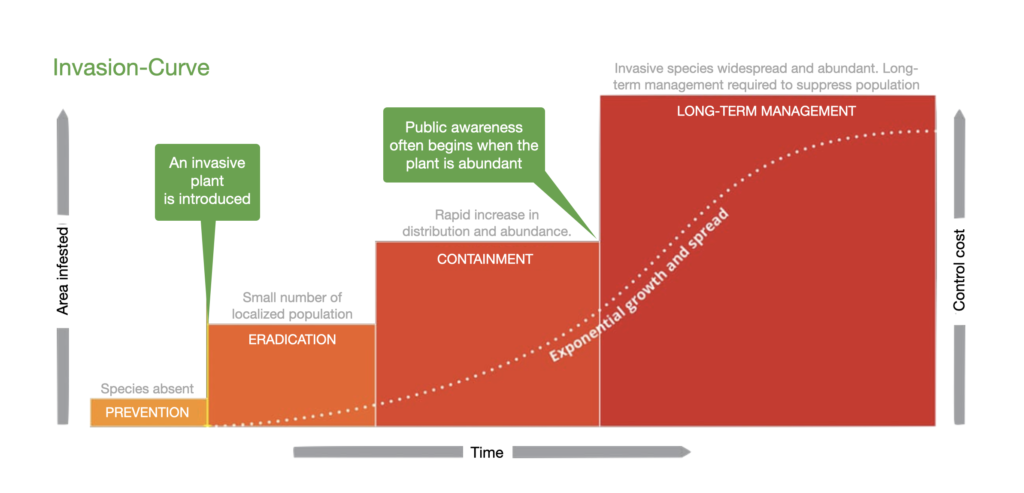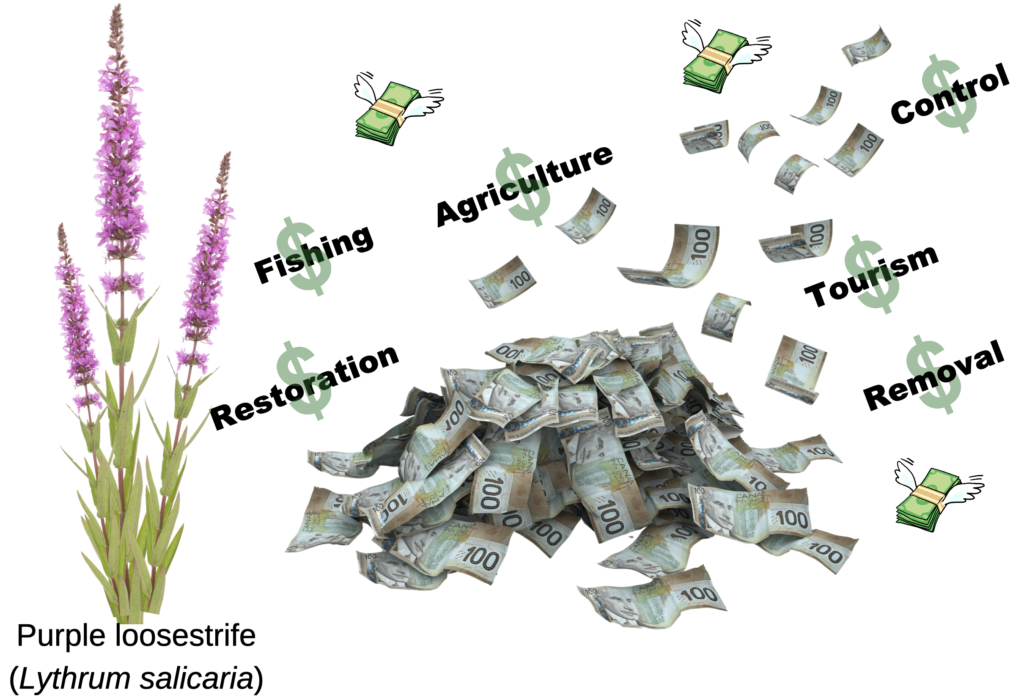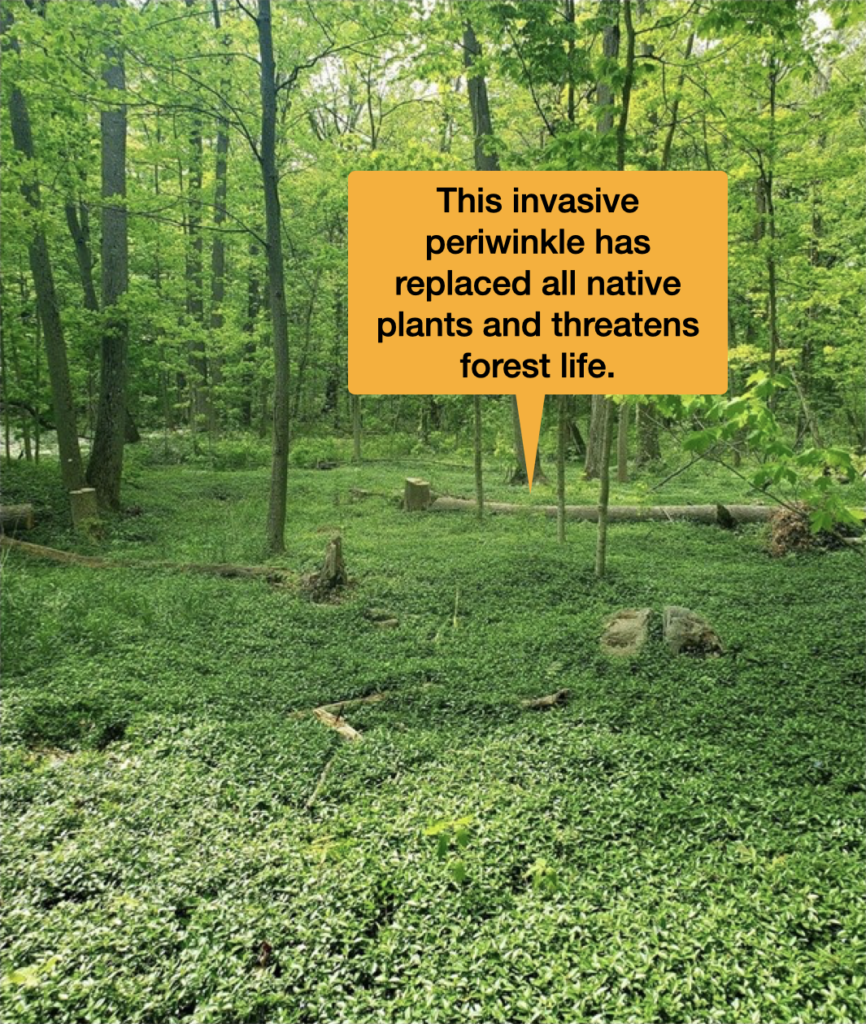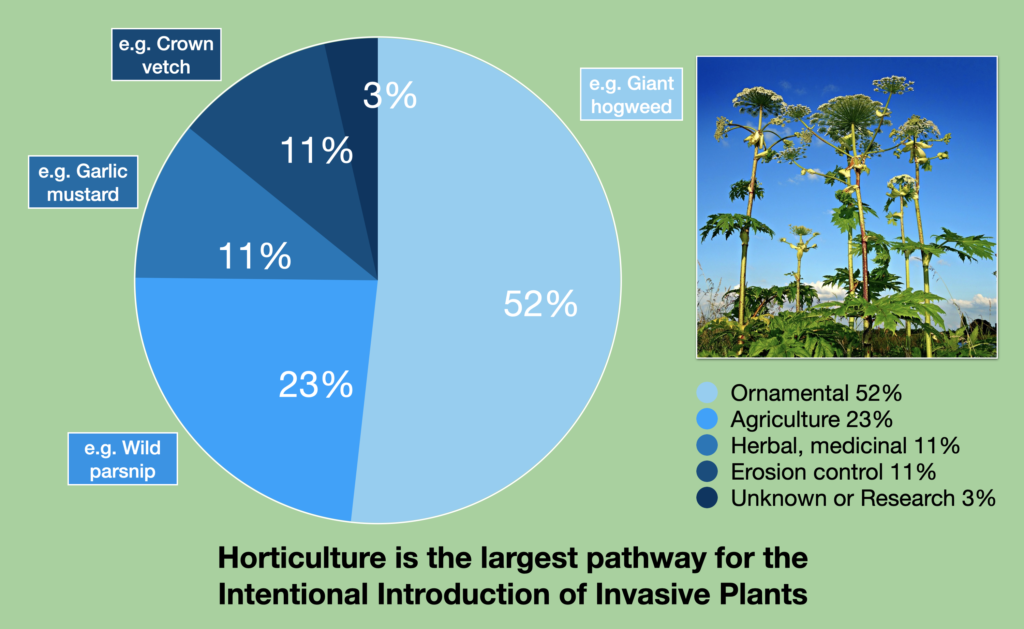The ornamental plant trade is the largest pathway for the introduction of non-native invasive plant species in Canada. Preventing introductions and reducing the spread of these plants is the most cost-effective means to protect against their harmful impacts.
Read our updated publication:
Reducing the sales of invasive plants in Canada: to safeguard biodiversity and human health. (Click the title above to open.)

To protect our environment, economy and public health from invasive plant species, the Canadian Coalition for Invasive Plant Regulation (CCIPR) believes Canada should improve policies, tools, and regulations by taking the following measures:
- Enhance Governance: Canada’s approach to managing invasive plants is disjointed and lacks unified oversight, leading to gaps in protection and response. Action required: Canada must establish a permanent body dedicated to overarching, inter-jurisdictional coordination for invasive species prevention and management.
- Create a Virtual Information Hub: Lack of information and resources hamper efforts to combat invasive species. Action required: Develop a central repository for sharing information on plants and their distribution, other technical information, decision-support tools, and best management practices related to invasive plants.
- Mandate Risk Assessments: Currently, only a small number of both newly imported and existing non-native plants undergo screening for invasiveness. Action required: Require risk assessments for all new plant imports and screen existing non-native plants for potential invasiveness.
- Reform Legislation: Canada’s invasive plant regulatory tools are aimed at safeguarding Canada’s food supply and plant resources but fall short of adequately protecting public health and the environment. Action required: Ban the sale and movement of high-risk invasive plant species and introduce point-of-sale labeling for plants that pose potential risks.
- Develop a National Invasive Plant Accord: Canada has not sufficiently engaged with industry leaders and other stakeholders to reduce the spread of invasive plants through the nursery trade. Action Required: Establish an agreement with industry to prevent the sale and/or distribution of invasive plants as has been successfully implemented in New Zealand (NPPA).
- Increase Public Education and Outreach: Educational programs are crucial to the success of Canada’s strategy against invasive plants, yet their effectiveness is compromised by inconsistent funding, infrequent revisions of educational materials, and uneven distribution across regions. Action required: Allocate and expand financial support for targeted educational campaigns that inform both the public and the nursery industry about invasive plants and necessary prevention and mitigation measures. Such investment will not only heighten the efficacy of these programs but also ensure a more equitable implementation of prevention measures across the country.
Prevention is Key
The increasing numbers of invasive plants entering Canada each year are having serious ecological and socio-economic consequences. Invasive non-native species spread quickly and the cost for their removal escalates over time making management nearly impossible. Preventing their introduction and establishment through improved legislation is the most logical and cost-effective course of action. Canada’s legislative framework on invasive plants is fragmented. Improved policies and a better coordinated regulatory process is needed at the federal, provincial and territorial levels.

The Time to Act is NOW – Help to Spread the Word
We need to work together to call for change. Your voice can make a difference. Join our mailing list. Become a Partner. Join our team – Get Involved.
We Can No Longer Afford to Ignore the Consequences
Invasive Alien Plant Species (IAPS) cause harm to the environment, the economy and human health. They can impact agriculture, forestry, recreation, biodiversity, ecosystem health, and public health. Control of these species costs hundreds of millions of dollars annually. Additionally, there are the inestimable costs to our natural environment — our life support system.

Ecological Costs and Consequences
Invasive plants can:
- Suppress or displace native plant species
- Disrupt essential food webs and impact wildlife
- Change litter decomposition, soil formation, soil chemistry and the distribution of soil organisms
- Reduce the availability of resources, like water or nutrients
- Impair essential ecosystem function and services, like pollination
- Diminish native habitats
- Reduce genetic diversity and global biodiversity

Social and health consequences
Economic consequences
- Increased hazards to human health (poisonings, allergies, dermatitis, injuries, disease – Lyme disease, West Nile virus)
- Threats to food production
- Diminished recreational opportunities (bird watching, hiking, camping)
- Depression and mental health impacts associated with losses and management
- Loss of our unique natural legacy (Indigenous cultural heritage, maple sugar production, beauty of Canadian landscapes)
- Costs for removal or control
- Negative impacts on agriculture, forestry and fisheries
- Loss of revenue from tourism, hunting, fishing and recreation
- Damage to infrastructure (e.g. drainage systems, transportation corridors)
- Increased risks of fire, erosion, and property damage
- Reduced property values
How Invasive Plants Arrive in Canada
According to the Canadian Food Inspection Agency (CFIA), the horticultural trade is the largest pathway for the intentional introduction of invasive plant species. Many invasive plants arrive as garden ornamentals and are sold to consumers who are unaware of their negative impacts.

Measures to prevent the spread of ornamental invasive plants at provincial or territorial borders are inconsistent or non-existent. Ontario is the only province that employs an explicit Invasive Species statute. Other provinces have regulatory tools, such as Alberta’s Weed Control Act and Manitoba’s Water Protection Amendment Act. A very small number of invasive plants in the horticultural trade are currently regulated.
A Growing Opportunity
While restrictions on invasive plants may be disruptive in the short term, there are opportunities for innovation – including potential for expanding local markets. Innovative nursery growers can capitalize on regional botanical uniqueness. Importers and breeders should focus on non-invasive plants that support our native pollinators, wildlife and or food production. This process can be transformative for the industry and ultimately benefit all Canadians and global biodiversity.
We must work together to stem the tide of invasive plant species. Legislation is needed now to reduce the escalating costs of management and protect our unique and precious heritage. By protecting our natural heritage from degradation, present and future generations can continue to enjoy the economic, social, and cultural opportunities a healthy environment provides.
About CCIPR
The Canadian Coalition for Invasive Plant Regulation (CCIPR) formed in early 2022 in response to an outcry from the public, voiced on the 28,500-member Master Gardeners of Ontario (MGOI) Facebook social media platform. A proposal to regulate plants in the horticultural trade was drafted by MGOI, a charitable organization dedicated to educating the public about sustainable gardening practices. A coalition of volunteers, representing organizations and individuals from across Ontario, then joined together around these objectives to become the Canadian Coalition for Invasive Plant Regulation. We are at the initial stages of organizing and building capacity. Individuals and organizations across Canada are invited to join and participate. Read Our Real-Life Origin Story.

Photo adapted from Helft Keitel

